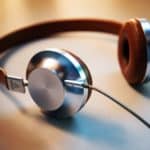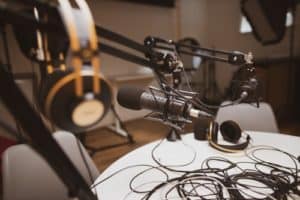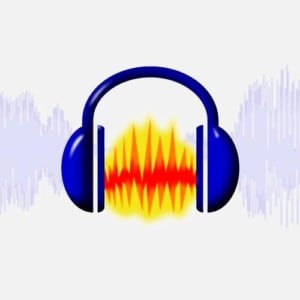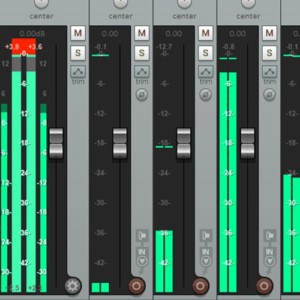Section Navigation
Introduction
Students will learn how sound works, and how to describe and understand its different aspects. When describing sound, we often borrow terms from the other senses, for example smooth, dark, heavy, bright. These are useful, but a standardized and less qualitative way of talking about and understanding sound is needed. As a student interested in becoming a sound designer or music producer, it is important to understand some fundamental concepts of how sound works. This knowledge builds an intuitive understanding behind the tools we use to create, capture and manipulate sound.
Learning Goals
This module prepares students to think creatively about how sound works in the world around them and in TV, film, and games.
Vocabulary
Bass - The lower range of audible frequencies.
Cycle - A complete positive (forward) and negative (backward) movement of a vibration corresponding to a high and low pressure wave.
Compression - The portion of a sound wave in which molecules are pushed together, forming a region with higher-than-normal atmospheric pressure.
Duration - The length of time a sound occurs.
Frequency - The speed of vibration of a sound wave, measured in cycles per second, or Hertz. Frequency determines pitch; the faster the frequency, the higher the pitch.
Hertz - The measuring unit of frequency or the speed of vibration of a sound wave per second.
Loudness - The subjective impression of the intensity of a sound.
Noise - Any sound that is undesired by the recipient. Interference of an electrical or acoustical nature.
Pitch - The human perception of frequency. In general, the higher the frequency, the higher the pitch.
Propagation - The act or process of transmitting, especially the process by which a disturbance, such as the motion of electromagnetic or sound waves, is spread through a medium such as air or water.
Quality - The subjective perception of the characteristics that make up a sound. Similar to timbre and often used interchangeably.
Rarefaction - The portion of a sound wave in which molecules are spread apart, forming a region with lower-than-normal atmospheric pressure. The opposite of compression.
Timbre - The subjective tonal quality of a sound.
Tonal - Capable of exciting an auditory sensation having pitch. Atonal is the opposite.
Treble - The higher frequencies of the audible spectrum.
Wave - A regular variation of an electrical signal or acoustical pressure.
Wavelength - The distance between the beginning and end of a wave or cycle.
Guiding Questions
Think of everything around you that makes a sound. What does each sound tell you about the thing making the sound? If you needed to explain something using only sound, how would you do it?
Curriculum Links
The concepts and vocabulary presented in this module provide a helpful foundation for an understanding of sound, which could be linked to an Arts and Music curriculum, and any other subject that makes use of sound recordings. For example, recording an interview in the community for a History, Heritage & Culture, or Civics and Economics project. Having a solid understanding of these concepts will help students as they start learning about the purpose and uses of digital audio workstations, microphones, recorders, and move into subsequent modules.
Non-Computer Activity
What is Sound? Sound is vibrations. These vibrations can move through different mediums such as solids and water, but the medium we are most familiar with is air.
An example to visually demonstrate how sound works is that of dropping a rock into water. The ripples that move out from the point of impact are similar to how sound moves, we call this outward movement propagation.
The ripples also demonstrate how sound travels. The water ripples in waves, and similarly with sound, the molecules in the air pass energy along in wave-like movements.
The peaks of the waves are compression, where molecules come together; and the valleys are the opposite, where molecules move apart, and is called rarefaction. This motion is how energy travels or propagates through a medium like air. Think of it like an echo of the rock impacting the water, fading as it loses energy over distance.
The length of time a sound lasts is called duration and is useful for describing how long a sound occurs.
Sound emanates not just on a surface, but in all directions unless it is obstructed. Throw another rock next to the first and see what happens!
We’ve thought about sound so far in relation to water, but now let’s think in terms of sound in air.
Sound in the air has a fixed speed, it moves 1,125 feet per second. We don’t need to memorize that number, but we do need to know that it always moves at the same speed.
A complete compression and decompression of a sound wave is called a cycle. Think of it as one ripple in and one ripple out.
The distance of a wave cycle is called a wavelength, and it determines the perceived pitch or frequency. Sound travels at the same speed through the air so the shorter the wavelength, the more frequently each wave hit our ears. The higher the frequency, the higher the sound (sometimes called treble); the lower the frequency, the lower the sound (bass).
The closer together waves are, the higher sound, like a squeak, and the further apart waves are, the lower sounds, like a thump!
We use the term hertz (or hz for short) to refer to the number of cycles of a wave that happen per second. The value is often used to define the pitch as well, for example, the note we call “A” in music theory is 440 hz.
We know that sound moves at a fixed speed, so that means the lower the hertz, the longer the wave needs to travel to complete a cycle, and the shorter the hertz, the less time it takes. For example, this means that a sound with a frequency of 100hz has a wavelength of about 10 feet.
This is why speakers that produce low sounds, called sub-woofers, are so large. More energy is required to move air with low sounds than higher sounds. This is why things that are smaller tend to produce higher sounds with less bass, while large ones produce sounds with more bass. Think of the ‘woof’ of a big dog versus the ‘yap’ of a little dog.
Though the range each person hears may be slightly different, and can change with age and with certain factors. For example, high listening volumes can damage our hearing and change how sensitive our ears are.
In sound design, these concepts help understand how and why the tools work the way they do. Things like recording, setting up your workstation, processing sounds, and exporting sound files.
But does this relate to how something sounds? When sound is created in the natural world, it is not just one simple wave, but a countless number of different sound events happening simultaneously, all interacting and blending together. When all those waves have different frequencies, it sounds likes noise.
The difference between noise and sounds we perceive not as noise, but music, is how the vibrations are organized.
We refer to a sound as tonal if all sounds coming from it have discernible pitch or frequency like singing, whistling, or the sound of an instrument like a violin.
We call a noise that doesn’t have a distinct pitch atonal.
Consider also the difference between whistling a long single note, compared to crumpling a piece of paper. That difference in sound is what we timbre. We also use the broader term, quality, to describe the general sonic character of a sound.
A violin has lots of different frequencies that makes up its timbre that could be characterized as noise, but its dominant sound is that of organized vibrations. Our voices contain a lot of noise and are often not entirely pitched to a note. The sound of different people’s voices, for example between an old man and young girl, is largely a difference of pitch and timbre.
Our ears are the physical parts that respond to these vibrations. Basically, our ears pick up vibrations in the air, convert them to electric energy, and send them through our nervous systems to our brains. This is the process through which we hear these vibrations.
One final characteristic of sound to consider is loudness. This is a topic that comes up often, and there are numerous ways to talk about how loudness is controlled through various sound design techniques.
Going back to our wave example, the loudness of a sound wave is illustrated by the height (energy) of the waves. The height of the wave is referred to as amplitude. But mainly loudness related to how much energy is being used to make a sound. This is what we are talking about when someone yells “turn it down!”
If a sound does not have enough loudness to be heard, from a listener’s perspective, that sound doesn’t exist. Controlling this characteristic of sound is a large part of what sound designers do.
Now that we’ve covered some basic characteristics of sound, you have some terms to help describe the quality of sounds you hear. Think about how the sounds in your environment. Are they loud, quiet, musical, noisy, beautiful, etc.? How do they make you feel? What can you understand about a thing by the quality of its sounds?
Asking yourself how a sound makes you think or feel is how a sound designer or music producer thinks. From the boom of an 808 kick drum, to the roar of a car engine, to the swing of a lightsaber, sound communicates information and elicits all kinds of feelings.
What kind of sounds does a bear make? What does your brain tell you about the bear just by what you hear? When our brain registers a low growling sound, it conveys a sense of danger and triggers our instincts to run!
Sound designers use people’s understanding of how things sound in the real world to communicate meaning, and also create original sounds that have never been heard before to make new meanings, or to make fictional things believable. For example, when a character shoots a laser gun, casts a spell, swings a lightsaber, speaks to a ghost, travels through time, or when a dinosaur roars. One of the jobs in sound design is to make those things come alive in a believable way.
What you think sounds best is how you find your own unique voice as a sound designer. Experiment with creating sounds. It’s lots of fun, and you’ll be surprised with what you can make.
Activity
Actions like clapping hands, dragging feet, tapping on a desk, and singing a note are all ways of generating sound. Furthermore, each environment where the sound is created will change the quality of it: for instance, if you stomp your feet on carpet, or on dry grass, or in a small room versus a large space. Use the terms learned in this module to talk about sounds you create.
Take a “soundwalk” with your class or by yourself. Listen and identify all the different sounds you hear in the environment, from the wind, to the sound of doors or hallways that echo. There are links to soundwalk guides in the resources section. In later modules students will be creating sounds for a game or video, so learning to consider sound with a more critical ear is important.
Example
Ben Burtt is renowned as one of the all-time great sound designers, and this featurette for Wall-E gives a fascinating overview of the history, process, and creativity of sound design.
Additional Activity
Using objects around the classroom, each student takes a turn creating a sound, while their classmates listen with their eyes closed and take guesses about what the sound designer is trying to make.
For example, a student may take their shoes and slap them together to make the sound of a seal flapping its flippers, or slide a chair across the floor to create a creaking noise (depending on the kind of chair and the kind of flooring, this action could imitate a variety of sounds!) It will be interesting to see what sounds are created, and the variety of responses from the other students, and it will demonstrate the interpretive nature of many sounds.
Alternatively, classes could play the “rain game” where they make the sound of a rainstorm by snapping their fingers and rubbing their hands together.
Conclusion
Discuss sounds from games, videos, movies, etc. and what the sound designer was trying to achieve and how the sound may have been made. All sounds in media are intentional; discuss the quality of these sounds, and what students would do to try and replicate these sounds with objects at their disposal. Discuss examples such as R2D2 and Wall-E, as they demonstrate how meaning is communicated through sound instead of dialogue.
Resources
- The work of R. Murray Schafer and his “Soundwalks” provide an excellent reference for listening exercises and environmental sound.
- Duckster is a science site for kids, this link gives a more technical description of sound.
- Media College is a resource for digital media production. They have a section about audio and other related subjects.
Books
- Sound Design: The Expressive Power of Music, Voice and Sound Effects in Cinema by David Sonnenschein covers conceptual aspects of sound design. It is more appropriate for older readers, but is an excellent starting point for thinking critically about sound design.
Videos
- A video that shows some of the more colorful ways sounds are created at the foley stage of doing sound design where performers perform sounds to picture with their bodies and props.
- Another video that demonstrates a sound creator making sounds with his body and various objects.
- Ted Talk by Tasos Fratzolas “The Beautiful Lies of Sound Design”




